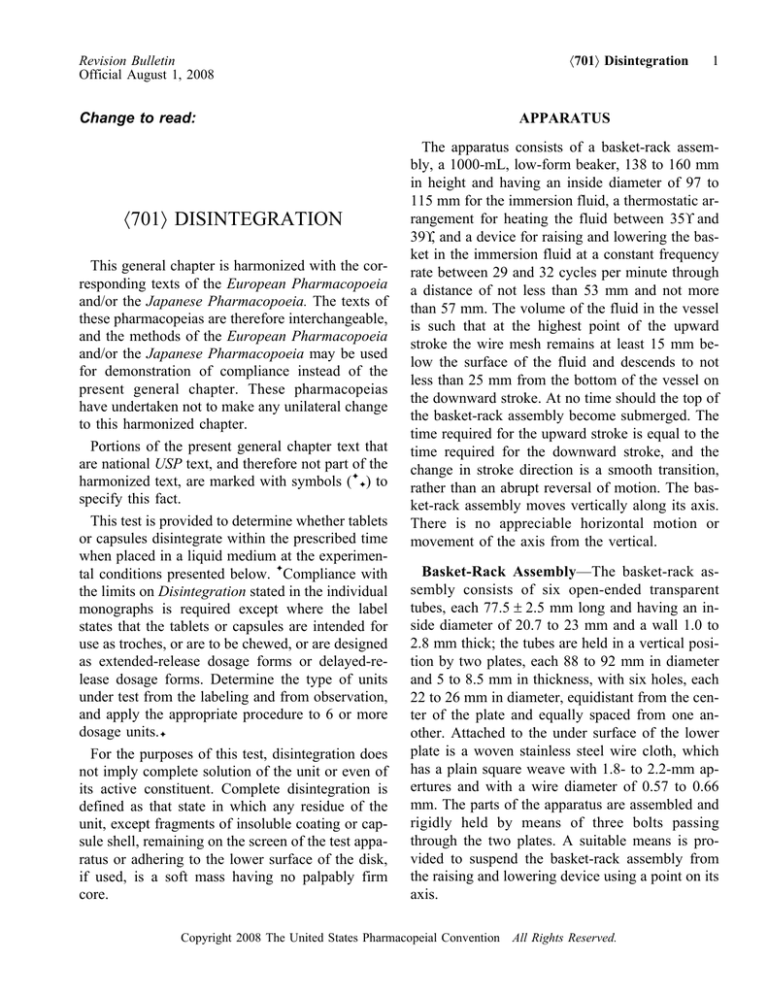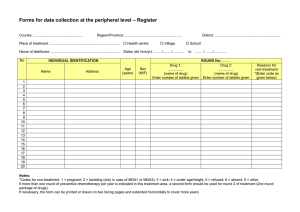
Revision Bulletin
Official August 1, 2008
Change to read:
⟨701⟩ DISINTEGRATION
This general chapter is harmonized with the corresponding texts of the European Pharmacopoeia
and/or the Japanese Pharmacopoeia. The texts of
these pharmacopeias are therefore interchangeable,
and the methods of the European Pharmacopoeia
and/or the Japanese Pharmacopoeia may be used
for demonstration of compliance instead of the
present general chapter. These pharmacopeias
have undertaken not to make any unilateral change
to this harmonized chapter.
Portions of the present general chapter text that
are national USP text, and therefore not part of the
harmonized text, are marked with symbols (✦✦) to
specify this fact.
This test is provided to determine whether tablets
or capsules disintegrate within the prescribed time
when placed in a liquid medium at the experimental conditions presented below. ✦Compliance with
the limits on Disintegration stated in the individual
monographs is required except where the label
states that the tablets or capsules are intended for
use as troches, or are to be chewed, or are designed
as extended-release dosage forms or delayed-release dosage forms. Determine the type of units
under test from the labeling and from observation,
and apply the appropriate procedure to 6 or more
dosage units.✦
For the purposes of this test, disintegration does
not imply complete solution of the unit or even of
its active constituent. Complete disintegration is
defined as that state in which any residue of the
unit, except fragments of insoluble coating or capsule shell, remaining on the screen of the test apparatus or adhering to the lower surface of the disk,
if used, is a soft mass having no palpably firm
core.
⟨701⟩ Disintegration
1
APPARATUS
The apparatus consists of a basket-rack assembly, a 1000-mL, low-form beaker, 138 to 160 mm
in height and having an inside diameter of 97 to
115 mm for the immersion fluid, a thermostatic arrangement for heating the fluid between 35° and
39°, and a device for raising and lowering the basket in the immersion fluid at a constant frequency
rate between 29 and 32 cycles per minute through
a distance of not less than 53 mm and not more
than 57 mm. The volume of the fluid in the vessel
is such that at the highest point of the upward
stroke the wire mesh remains at least 15 mm below the surface of the fluid and descends to not
less than 25 mm from the bottom of the vessel on
the downward stroke. At no time should the top of
the basket-rack assembly become submerged. The
time required for the upward stroke is equal to the
time required for the downward stroke, and the
change in stroke direction is a smooth transition,
rather than an abrupt reversal of motion. The basket-rack assembly moves vertically along its axis.
There is no appreciable horizontal motion or
movement of the axis from the vertical.
Basket-Rack Assembly—The basket-rack assembly consists of six open-ended transparent
tubes, each 77.5 ± 2.5 mm long and having an inside diameter of 20.7 to 23 mm and a wall 1.0 to
2.8 mm thick; the tubes are held in a vertical position by two plates, each 88 to 92 mm in diameter
and 5 to 8.5 mm in thickness, with six holes, each
22 to 26 mm in diameter, equidistant from the center of the plate and equally spaced from one another. Attached to the under surface of the lower
plate is a woven stainless steel wire cloth, which
has a plain square weave with 1.8- to 2.2-mm apertures and with a wire diameter of 0.57 to 0.66
mm. The parts of the apparatus are assembled and
rigidly held by means of three bolts passing
through the two plates. A suitable means is provided to suspend the basket-rack assembly from
the raising and lowering device using a point on its
axis.
Copyright 2008 The United States Pharmacopeial Convention All Rights Reserved.
2
⟨701⟩ Disintegration
The design of the basket-rack assembly may be
varied somewhat, provided the specifications for
the glass tubes and the screen mesh size are maintained. The basket-rack assembly conforms to the
dimensions found in Figure 1.
Disks—The use of disks is permitted only where
specified or allowed ✦in the monograph. If specified in the individual monograph,✦ each tube is
provided with a cylindrical disk 9.5 ± 0.15 mm
thick and 20.7 ± 0.15 mm in diameter. The disk is
made of a suitable transparent plastic material having a specific gravity of between 1.18 and 1.20.
Five parallel 2 ± 0.1-mm holes extend between the
ends of the cylinder. One of the holes is centered
on the cylindrical axis. The other holes are centered 6 ± 0.2 mm from the axis on imaginary lines
perpendicular to the axis and parallel to each other.
Four identical trapezoidal-shaped planes are cut
into the wall of the cylinder, nearly perpendicular
to the ends of the cylinder. The trapezoidal shape
is symmetrical; its parallel sides coincide with the
ends of the cylinder and are parallel to an imaginary line connecting the centers of two adjacent
holes 6 mm from the cylindrical axis. The parallel
side of the trapezoid on the bottom of the cylinder
has a length of 1.6 ± 0.1 mm, and its bottom edges
lie at a depth of •1.5 to 1.8 mm•(RB 2008-08-01) from
the cylinder’s circumference. The parallel side of
the trapezoid on the top of the cylinder has a
length of 9.4 ± 0.2 mm, and its center lies at a
depth of 2.6 ± 0.1 mm from the cylinder’s circumference. All surfaces of the disk are smooth. If the
use of disks is specified ✦in the individual
monograph✦, add a disk to each tube, and operate
the apparatus as directed under Procedure. The
disks conform to dimensions found in Figure 11 .
The use of automatic detection employing modified disks is permitted where the use of disks is
specified or allowed. Such disks must comply with
the requirements for density and dimension given
in this chapter.
1
Revision Bulletin
Official August 1, 2008
PROCEDURE
✦
Uncoated Tablets—✦Place 1 dosage unit in
each of the six tubes of the basket and, if prescribed, add a disk. Operate the apparatus, using
✦
water or✦ the specified medium as the immersion
fluid, maintained at 37 ± 2°. At the end of the time
limit specified ✦in the monograph,✦ lift the basket
from the fluid, and observe the tablets: all of the
tablets have disintegrated completely. If 1 or 2 tablets fail to disintegrate completely, repeat the test
on 12 additional tablets. The requirement is met if
not fewer than 16 of the total of 18 tablets tested
are disintegrated.
✦
Plain-Coated Tablets—Apply the test for Uncoated Tablets, operating the apparatus for the
time specified in the individual monograph.
Delayed-Release (Enteric-Coated) Tablets—
Place 1 tablet in each of the six tubes of the basket
and, if the tablet has a soluble external sugar coating, immerse the basket in water at room temperature for 5 minutes. Then operate the apparatus using simulated gastric fluid TS maintained at
37 ± 2° as the immersion fluid. After 1 hour of operation in simulated gastric fluid TS, lift the basket
from the fluid, and observe the tablets: the tablets
show no evidence of disintegration, cracking, or
softening. Operate the apparatus, using simulated
intestinal fluid TS maintained at 37 ± 2° as the immersion fluid, for the time specified in the monograph. Lift the basket from the fluid, and observe
the tablets: all of the tablets disintegrate completely. If 1 or 2 tablets fail to disintegrate completely, repeat the test on 12 additional tablets: not
fewer than 16 of the total of 18 tablets tested disintegrate completely.
Buccal Tablets—Apply the test for Uncoated
Tablets. After 4 hours, lift the basket from the
fluid, and observe the tablets: all of the tablets
have disintegrated. If 1 or 2 tablets fail to disintegrate completely, repeat the test on 12 additional
tablets: not fewer than 16 of the total of 18 tablets
tested disintegrate completely.
Sublingual Tablets—Apply the test for Uncoated Tablets. At the end of the time limit speci-
Copyright 2008 The United States Pharmacopeial Convention All Rights Reserved.
Revision Bulletin
Official August 1, 2008
⟨701⟩ Disintegration
3
Figure 1. Disintegration apparatus. (All dimensions are expressed in mm.)•(RB 2008-08-01)
fied in the individual monograph: all of the tablets
have disintegrated. If 1 or 2 tablets fail to disintegrate completely, repeat the test on 12 additional
tablets: not fewer than 16 of the total of 18 tablets
tested disintegrate completely.
Hard Gelatin Capsules—Apply the test for Uncoated Tablets. Attach a removable wire cloth,
which has a plain square weave with 1.8- to 2.2mm mesh apertures and with a wire diameter of
0.60 to 0.655 mm, as described under Basket-Rack
Assembly, to the surface of the upper plate of the
basket-rack assembly. Observe the capsules within
the time limit specified in the individual monograph: all of the capsules have disintegrated except
for fragments from the capsule shell. If 1 or 2 capsules fail to disintegrate completely, repeat the test
on 12 additional capsules: not fewer than 16 of the
total of 18 capsules tested disintegrate completely.
Soft Gelatin Capsules—Proceed as directed
under Hard Gelatin Capsules.✦
Copyright 2008 The United States Pharmacopeial Convention All Rights Reserved.






